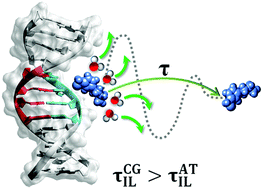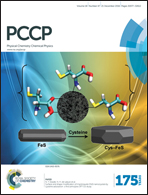Water modulates the ultraslow dynamics of hydrated ionic liquids near CG rich DNA: consequences for DNA stability†
Abstract
Ionic liquids are known to stabilize DNA for much longer than water can. While the source of this stability has commonly been attributed to thermodynamic aspects, we probe the dynamical aspects of the ionic liquids near DNA to further our understanding of this stability. Using molecular dynamics simulation, we calculated the mean residence time (MRT) of the cations of five different ionic liquids (ILs) in the grooves and around phosphate groups of AT and CG rich DNA segments. We find the residence time of different cations next to CG rich DNA to be much higher compared to that next to AT rich DNA, with a negligible difference with the variation of anions. The interaction energy between cations and DNA, however, shows exactly the opposite trend; it is much lower (indicating a stronger interaction) for AT than for CG. Investigation of DNA parameters reveals an insignificant difference for the DNA sequences under consideration. Analysis of water behavior provides a rationale for the long MRTs of cations; water molecules have been found to be denser and to possess higher MRT when next to CG-rich DNA, thus resulting in a crowded environment. Our results indicate that the dynamics influence the binding of ILs to different DNA sequences, possibly by modulating the entropy of the binding process.



 Please wait while we load your content...
Please wait while we load your content...